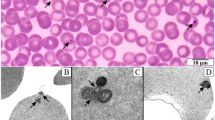Abstract
In-vitro-propagated Babesiacaballi parasites were examined by scanning and transmission electron microscopy. Many small pores were observed over the entire surface of infected erythrocytes on scanning electron microscopy, and on transmission electron microscopy these small pores were found to be openings of tubular structures. By the examination of a number of infected cells the tubular structures were found to be connected with the parasite, and this observation might indicate that the tubular structures arose from the edge of the parasite and terminated at an invagination on the surface of the erythrocyte. These findings suggest that intraerythrocytic stages of B.caballi come into direct contact with culture medium.
Similar content being viewed by others
Author information
Authors and Affiliations
Additional information
Received: 10 August 1998 / Accepted: 17 August 1998
Rights and permissions
About this article
Cite this article
Kawai, S., Igarashi, I., Abgaandorjiin, A. et al. Tubular structures associated with Babesia caballi in equine erythrocytes in vitro. Parasitol Res 85, 171–175 (1999). https://doi.org/10.1007/s004360050530
Issue Date:
DOI: https://doi.org/10.1007/s004360050530




